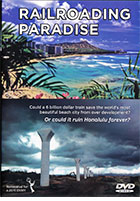
Railroading Paradise 2014
Distributed by Collective Eye Films, 2305 SE Yamhill Street, Suite 101, Portland OR 97214; 503-232-5345
Produced by Anthony Aalto and Mike Hinchey for Green Island Films
Directed by Anthony Aalto and Mike Hinchey
DVD, color, 58 min.
Middle School - General Adult
Politics, Transportation, Urban Areas
Date Entered: 07/01/2015
Reviewed by Cliff Glaviano, formerly with Bowling Green State University Libraries, Bowling Green, OHIn 2008 voters in Honolulu narrowly passed a referendum supporting the building of a controversial high speed rail line on Oahu. Proponents saw high speed rail as a potential cure for the highway congestion impacting the economy and limiting population growth and tourism. Opponents saw the loss of agricultural land and increased development as a negative impact on the quality of life, essentially as the loss of the traditional Hawaiian lifestyle. As the 2012 mayoral election in Honolulu neared, opponents of the project saw that by electing the “right” mayor they could stop or reverse the rail project.
The filmmakers give very balanced coverage to both sides of an extremely intricate problem. As housing development increased so did the labor economy. Slowing housing development meant increased unemployment. As transportation from suburban housing to the city overtaxed the highway system, easily accessible housing became increasingly unaffordable and the tourism industry suffered. Though high speed rail with new communities clustered along the rail line promised to ease strains on the road system, opponents suggested that the rail plan was just a ruse to increase building construction which had no strategy for enticing residents to rely less on personal automobiles. Interviews with stakeholders from both sides and with varied cultural and environmental interests form the bulk of the program. These include the deliberations of the Board of the Oahu branch of the Sierra Club which are quite emotionally and politically charged.
Clearly there are limits to sustainable growth. Railroading Paradise reminds the viewer that for growth to succeed in a compact area with high population density, consensus must be achieved through considering the needs of every aspect of society, working to fulfill those needs by the best means possible. The film is highly recommended for giving the viewer insight into the complexities of urban planning, stressing the importance of local history and considering traditional cultural values throughout the planning process. It is a sometimes surprising tale of ongoing development in greater Honolulu which may serve to solve their housing and transportation problems. It is not a blueprint for urban development elsewhere, though it may point the way toward considerations and deliberations that may promote the best use of resources in an urban community.